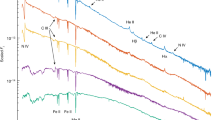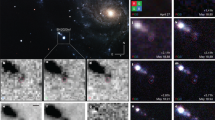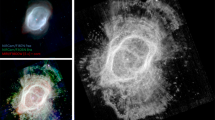Abstract
η Carinae is one of the most massive binary stars in the Milky Way1,2. It became the second-brightest star in our sky during its mid-nineteenth-century ‘Great Eruption’, but then faded from view (with only naked-eye estimates of brightness3,4). Its eruption is unique in that it exceeded the Eddington luminosity limit for ten years. Because it is only 2.3 kiloparsecs away, spatially resolved studies of the nebula have constrained the ejected mass and velocity, indicating that during its nineteenth-century eruption, η Car ejected more than ten solar masses in an event that released ten per cent of the energy of a typical core-collapse supernova5,6, without destroying the star. Here we report observations of light echoes of η Carinae from the 1838–1858 Great Eruption. Spectra of these light echoes show only absorption lines, which are blueshifted by −210 km s−1, in good agreement with predicted expansion speeds6. The light-echo spectra correlate best with those of G2-to-G5 supergiants, which have effective temperatures of around 5,000 kelvin. In contrast to the class of extragalactic outbursts assumed to be analogues of the Great Eruption of η Carinae7,8,9,10,11,12, the effective temperature of its outburst is significantly lower than that allowed by standard opaque wind models13. This indicates that other physical mechanisms such as an energetic blast wave may have triggered and influenced the eruption.
This is a preview of subscription content, access via your institution
Access options
Subscribe to this journal
Receive 51 print issues and online access
$199.00 per year
only $3.90 per issue
Buy this article
- Purchase on Springer Link
- Instant access to full article PDF
Prices may be subject to local taxes which are calculated during checkout




Similar content being viewed by others
References
Davidson, K. & Humphreys, R. M. Eta Carinae and its environment. Annu. Rev. Astron. Astrophys. 35, 1–32 (1997)
Damineli, A. The 5.52 year cycle of eta Carinae. Astrophys. J. 460, L49 (1996)
Frew, D. J. The historical record of η Carinae I. The visual light curve, 1595–2000. J. Astron. Data 10, 6 (2004)
Smith, N. & Frew, D. J. A revised historical light curve of eta Carinae and the timing of close periastron encounters. Mon. Not. R. Astron. Soc. 415, 2009–2019 (2011)
Smith, N. et al. Mass and kinetic energy of the Homunculus nebula around η Carinae. Astron. J. 125, 1458–1466 (2003)
Smith, N. A blast wave from the 1843 eruption of η Carinae. Nature 455, 201–203 (2008)
Goodrich, R. W., Stringfellow, G. S., Penrod, G. D. & Filippenko, A. V. S. N. 1961V—an extragalactic ETA Carinae analog. Astrophys. J. 342, 908–916 (1989)
Humphreys, R. M. & Davidson, K. The luminous blue variables: astrophysical geysers. Publ. Astron. Soc. Pacif. 106, 1025–1051 (1994)
Humphreys, R. M., Davidson, K. & Smith, N. Eta Carinae’s second eruption and the light curves of the eta Carinae variables. Publ. Astron. Soc. Pacif. 111, 1124–1131 (1999)
Van Dyk, S. D. et al. SN 1997bs in M66: another extragalactic η Carinae analog? Publ. Astron. Soc. Pacif. 112, 1532–1541 (2000)
Vink, J. S. Eta Carinae and the luminous blue variables. Preprint at http://arxiv.org/abs/0905.3338 (2009)
Kashi, A., Frankowski, A. & Soker, N. NGC 300 OT2008–1 as a scaled down version of the eta Carinae great eruption. Astrophys. J. 709, L11–L15 (2010)
Davidson, K. The relation between apparent temperature and mass-loss rate in hypergiant eruptions. Astrophys. J. 317, 760–764 (1987)
Bagnulo, S. et al. The UVES Paranal Observatory Project: a library of high- resolution spectra of stars across the Hertzsprung-Russell diagram. The Messenger 114, 10–14 (2003)
Cenarro, A. J. et al. Empirical calibration of the near-infrared Ca ii triplet—I. The stellar library and index definition. Mon. Not. R. Astron. Soc. 326, 959–980 (2001)
Smith, N. The structure of the Homunculus. I. Shape and latitude dependence from H2 and [Fe II] velocity maps of η Carinae. Astrophys. J. 644, 1151–1163 (2006)
Smith, N., Vink, J. S. & de Koter, A. The missing luminous blue variables and the bistability jump. Astrophys. J. 615, 475–484 (2004)
Le Sueur, A. On the nebulae of Argo and Orion, and on the spectrum of Jupiter. Proc. R. Soc. Lond. I 18, 245–250 (1869)
Le Sueur, A. Observations with the Great Melbourne telescope, in a letter to Prof. Stokes. Proc. R. Soc. Lond. I 19, 18–19 (1870)
Walborn, N. R. & Liller, M. H. The earliest spectroscopic observations of eta Carinae and its interaction with the Carina nebula. Astrophys. J. 211, 181–183 (1977)
Humphreys, R. M., Davidson, K. & Koppelman, M. The early spectra of eta Carinae 1892 to 1941 and the onset of its high excitation emission spectrum. Astron. J. 135, 1249–1263 (2008)
Smith, N. Doppler tomography of the Little Homunculus: high-resolution spectra of [FeII]λ16435 around eta Carinae*. Mon. Not. R. Astron. Soc. 357, 1330–1336 (2005)
Smith, N., Li, W., Silverman, J. M., Ganeshalingam, M. & Filippenko, A. V. Luminous blue variable eruptions and related transients: diversity of progenitors and outburst properties. Mon. Not. R. Astron. Soc. 415, 773–810 (2011)
Rest, A. et al. Light echoes from ancient supernovae in the Large Magellanic Cloud. Nature 438, 1132–1134 (2005)
Rest, A. et al. Scattered-light echoes from the historical galactic supernovae Cassiopeia A and Tycho (SN 1572). Astrophys. J. 681, L81–L84 (2008)
Rest, A. et al. On the interpretation of supernova light echo profiles and spectra. Astrophys. J. 732, 2 (2011)
Smith, N. et al. Discovery of precursor luminous blue variable outbursts in two recent optical transients: the fitfully variable missing links UGC 2773-OT and SN 2009ip. Astron. J. 139, 1451–1467 (2010)
Foley, R. J. et al. The diversity of massive star outbursts. I. Observations of SN2009ip, UGC 2773 OT2009–1, and their progenitors. Astrophys. J. 732, 32 (2011)
Acknowledgements
We thank R. Humphreys, K. Davidson and J. Vink for comments and discussions. We thank S. Blondin for help with the continuum subtraction. The Blanco 4-m telescope is a facility of the Cerro Tololo Inter-American Observatory, National Optical Astronomy Observatory, which is operated by the Association of Universities for Research in Astronomy, under contract with the National Science Foundation. We use data from the UVES Paranal Observatory Project. The computations in this paper were run on the Odyssey cluster supported by the FAS Science Division Research Computing Group at Harvard University. Observations were obtained at LCOGT, and F.B.B. and D.A.H. acknowledge support from LCOGT. J.L.P. is a Hubble Carnegie-Princeton Fellow. R.J.F. is a Clay Fellow.
Author information
Authors and Affiliations
Contributions
All authors contributed to the drafting of the paper. A.R., N.S. and R.C.S. imaged the area around η Car. A.R. and M.E.H. reduced the imaging data. H.E.B. provided images of the echoes that guided our spectroscopic pointings. J.L.P., R.C., R.J.F. and W.F. obtained the spectra and reduced them. A.R. and J.L.P. performed spectral analysis and interpretation. A.R., N.R.W. and F.B.B. performed spectral classification. F.B.B. and K.M. correlated the spectra. A.R., D.L.W. and B.S. modelled the light echo. I.T. and D.M. provided imaging of η Car. F.B.B. and D.A.H. provided the FTS images, and F.B.B. and A.R. reduced them.
Corresponding author
Ethics declarations
Competing interests
The authors declare no competing financial interests.
Supplementary information
Supplementary Information
This file contains Supplementary Text, Supplementary Tables 1-5, additional references and Supplementary Figures 1-3 with legends. (PDF 790 kb)
Rights and permissions
About this article
Cite this article
Rest, A., Prieto, J., Walborn, N. et al. Light echoes reveal an unexpectedly cool η Carinae during its nineteenth-century Great Eruption. Nature 482, 375–378 (2012). https://doi.org/10.1038/nature10775
Received:
Accepted:
Published:
Issue Date:
DOI: https://doi.org/10.1038/nature10775
This article is cited by
-
Simulations of common-envelope evolution in binary stellar systems: physical models and numerical techniques
Living Reviews in Computational Astrophysics (2023)
-
Echoes from an old outburst
Nature (2012)
-
The Great Eruption of η Carinae
Nature (2012)
-
Rest et al. reply
Nature (2012)
-
Light echoes cause rethink of supernova imposter
Nature (2012)
Comments
By submitting a comment you agree to abide by our Terms and Community Guidelines. If you find something abusive or that does not comply with our terms or guidelines please flag it as inappropriate.



